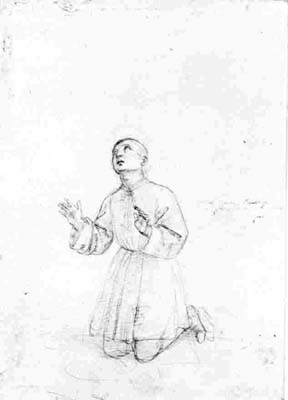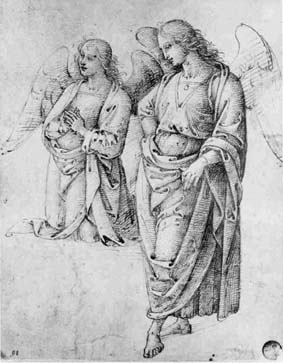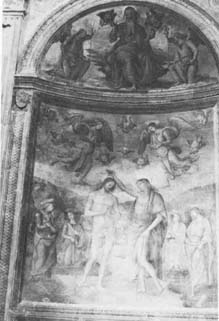
Annual Bulletin 3, 1979-1980
Home
Français
Introduction
History
Annual Index
Author &
Subject
Credits
Contact
![]()



A Re-Examination of the "Raphael"
drawing in the National Gallery of Canada
by Sylvia Ferino
Article en français
Pages 1 | 2 |
3 | 4
The drawing of a youth with hands folded in prayer, preserved in three-quarter
length, was acquired in 1939 by the National Gallery of Canada as an authentic
Raphael (fig. 1). (1) This attribution goes back to Padre Resta, who owned
the drawing as the inventory number g 108 at the foot of the drawing shows,
and who had commented on it as follows:
di Raffaello divenuto migliore del suo Mastro quanto allo stile piu facilitato a di 18 Novembre 1689 mi fu mandato in dono da Palermo del Pittore Antonino Gianguzzo ò sia Gianucci Palermitano, non senza opinione sua che fusse di Vincenzo Animola detto Vincenzo Romano da Palermo scolaro di Raffaelle. (2)Although aware neither of the drawing's pedigree nor of Resta's opinion, Fischel expressed the same view. (3) He also considered the drawing to be by Raphael at a time when he was still closely connected with Perugino, and he believed that the figure was an early sketch for St John the Evangelist in Raphael's Mond Crucifixion (fig. 2). This painting dates from about 1503 and is indeed Raphael's most obviously Peruginesque work. Subsequent scholarship, led by Popham, supported Fischel's view, and inquired further into the purpose of the study. It was, for instance, suggested that the figure was a preparatory study for Mary Magdalen in the same painting rather than for St John. (5) But so far, Raphael's authorship has not been questioned.
There is another drawing by Raphael in the Ashmolean Museum, in Oxford, which shows a kneeling youth looking upwards with hands raised in a gesture of devotion and, like the Ottawa study, is carried out in metal-point on warm white preparation (fig. 3). (6) This drawing has also been attributed to Raphael in connection with the Mond Crucifixion. However, if we compare the two drawings we can see immediately that they are the work of two distinctly different personalities. While the Ashmolean youth is, clearly, drawn after a live model in contemporary dress, the Ottawa youth appears in an idealized costume, just as we might expect to find him in the painting. The features of the Ashmolean youth are not individualized, but they show a greater degree of articulation and the whole body is more precisely grasped and blocked out. Pentimenti such as those in the pose of the figure's left leg bear witness to the artist's search for correct foreshortening. Every part of the body is precisely determined in relation to the whole figure and to the space it occupies. The figure, in fact, breathes space by reaching fully into it. The upward tilt of the head is clearly visualized as are the bends in the waist, arms and knees.
The uneven contouring heightens the impression of spontaneity for the artist has repeatedly emphasized certain parts of the body while barely indicating others. The modelling emphasizes the physical three-dimensional qualities of the image, giving it an appearance of greater vitality than in the Ottawa drawing by means of layers of generously-spaced parallel hatchings condensed into patches in the deeper shadows.
All these qualities are lacking in the Ottawa youth. The whole attitude of the figure and the details of the body are less precise and less articulated than they are in the Ashmole an drawing. The head is softly inclined and the arms bend less emphatically. Strong foreshortening is avoided. The figure is more two-dimensional than the Ashmolean youth. There is a feeling of gentle submissiveness quite different from the Ashmolean youth 's ardent pleading. The graphic handling in rhythmic curves and hatches which are less modulated ties the figure to the plane and renders the image more elusive and remote.
Both drawings, no doubt, aim at an ideal representation of the human figure. But, there is much more stringency and depth in the Oxford image than in the Ottawa youth. And it is these differences which, from the start, separate Raphael's creations from those of Perugino. Although cast in the same spirit of pious devotion, Raphael's saints are more vitally human and closer to nature even if at times, they appear less perfectly graceful than Perugino's angelic creatures. (7)
While the Oxford youth does correspond to Raphael's artistic concept, the Ottawa figure is more typical of Perugino's. The latter relates indeed to one of Perugino's finished projects, as may be seen from the following examples. A drawing in Venice, carried out in pen and brown ink, shows two angels - one kneeling, the other standing upright - both turned towards the left, apparently concentrating on a central event to their right (fig. 4). (8) These two figures are well spaced on the page and handled in tight crosshatchings. They clearly belong to that category of Umbrian workshop drawings carried out by shop associates and imitators after Perugino's compositions.
The model for this particular drawing was a famous fresco painted by Perugino in 1507 in the Nunziatella at Foligno and representing the Baptism of Christ (fig. 5). (9) This composition became extremely popular in Umbrian Ciriquecento painting and was repeated in various techniques and with multiple variations by the master himself; by various former workshop associates, and by followers such as Bernardino di Mariotto in the SS Annunziata in Camerino. (10)
There is a vast number of drawings in which specific parts of Perugino's composition are recorded: for instance, a sheet in the Staedel, in Frankfurt, depicts the central event in the Baptism; a sheet in Madrid and another in new York depict the same two angels, as in the Venice sheet (fig. 4); and there are many others. (11) Many of the single figures reappear inserted in various Umbrian paintings and frescoes: our angel appears, for instance, in one of Tiberio d'Assisi's scenes in the Miracle of the Roses in the Capella del Roseto in S Maria degli Angeli in Assisi. (12) It was by means of these vast collections of reproductive drawings, which local artists produced for their own purposes, that Perugino's inventions were circulated and spread throughout Italy.
Next Page | three figures
1 | 2 | 3 | 4
Annual Index | Author & Subject | Credits | Contact
This digital collection
was produced under contract to Canada's Digital Collections program,
Industry Canada.
"Digital
Collections Program, Copyright
© National Gallery of
Canada 2001"